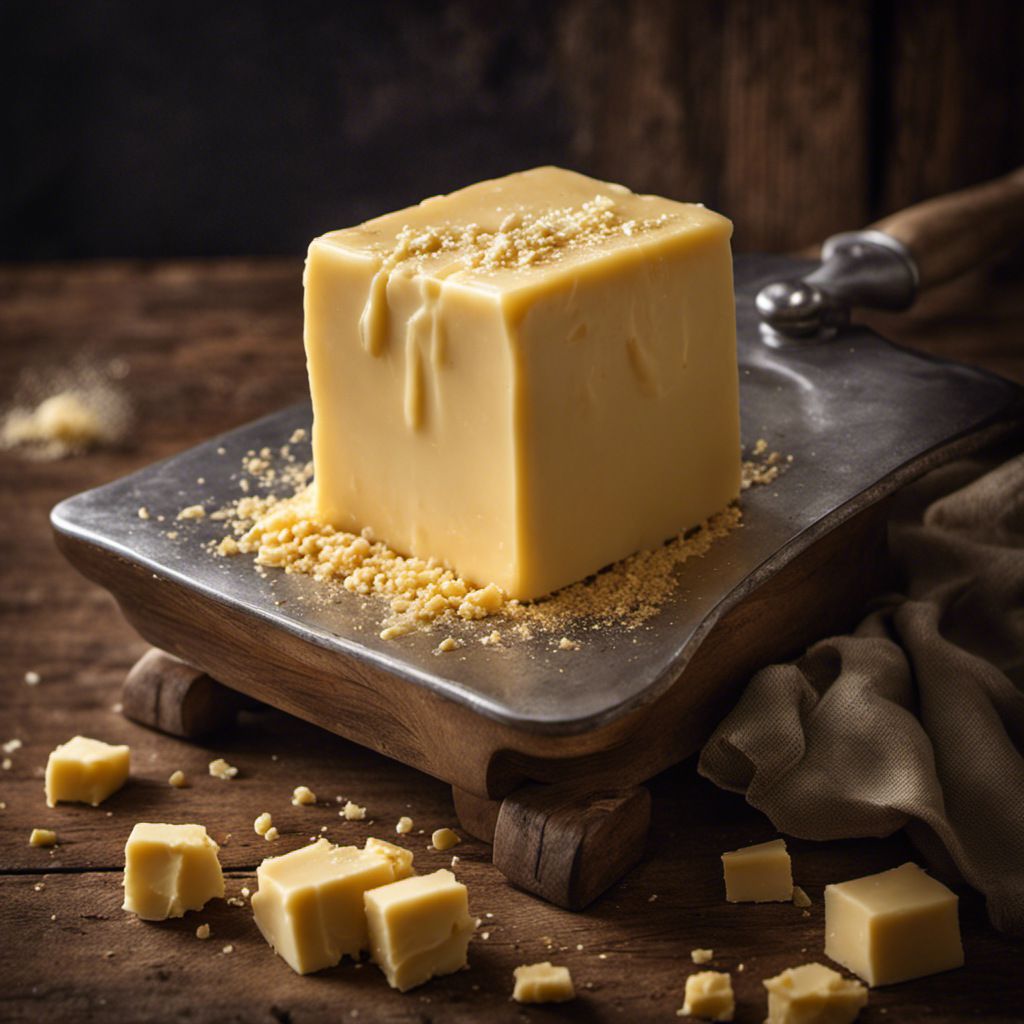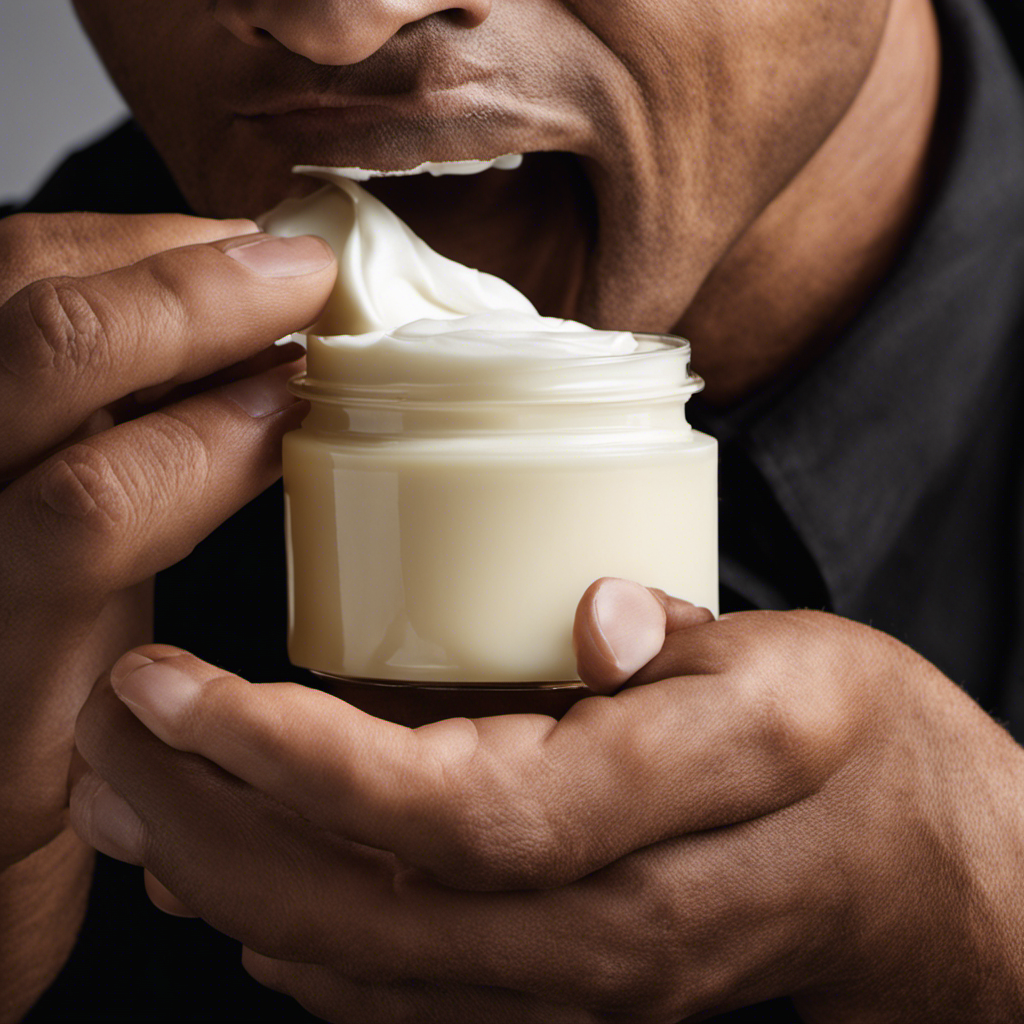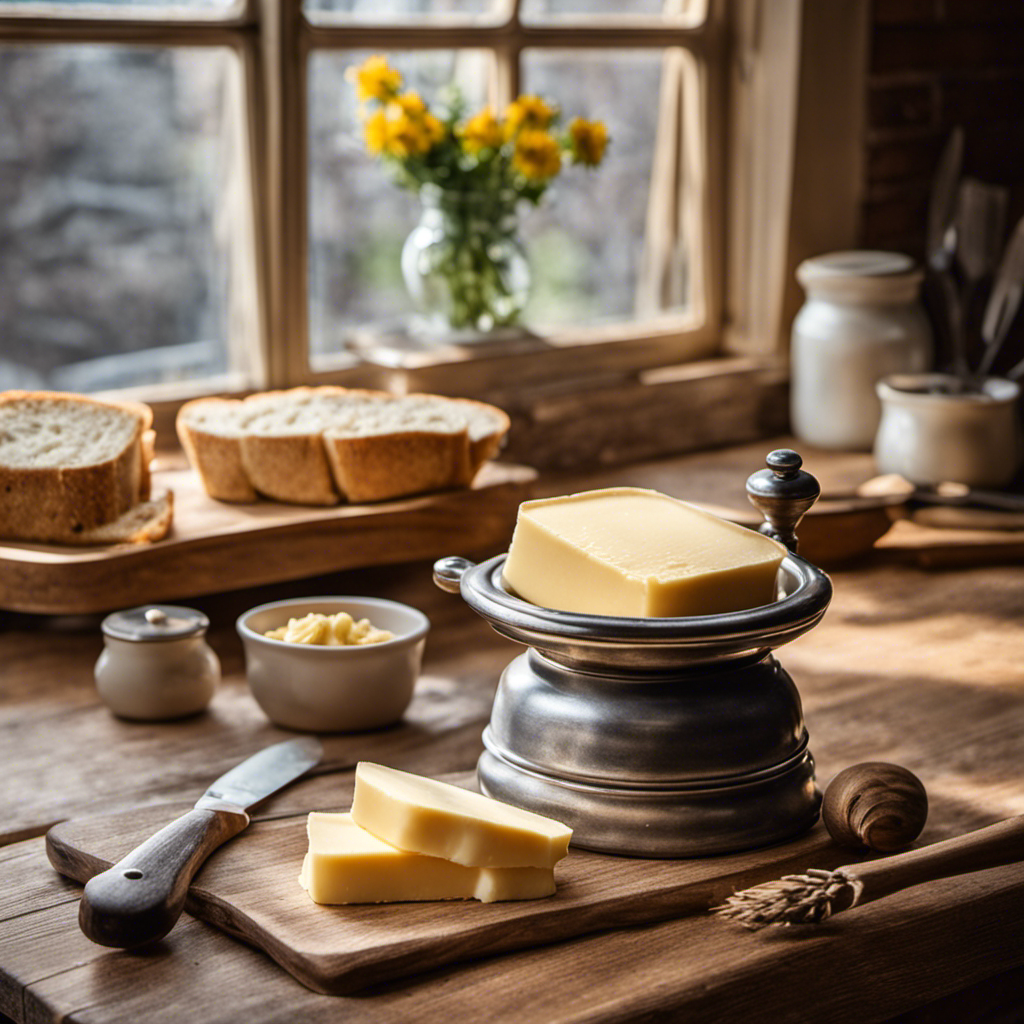I have always been intrigued by the real cost of butter. It is a staple in many kitchens, yet its price seems to fluctuate unpredictably. As a result, I set out on a journey to uncover the secrets of the butter market.
In this article, we’ll delve into the price variations of butter in different countries, explore the factors that affect its cost, and even compare it to its popular counterpart, margarine.
Get ready to dive deep into the economics of butter production and discover how it impacts the food industry.
Key Takeaways
- Butter prices are influenced by factors such as tariffs, supply and demand dynamics, production costs, market competition, and government policies and regulations.
- Supply and demand dynamics play a significant role in determining butter prices, with high demand and limited supply, government policies affecting availability, consumer preferences for healthier alternatives, and price elasticity of butter consumption all impacting the market.
- Production and distribution factors, including transportation costs, storage facilities, availability of raw materials, and production techniques and distribution channels, also affect butter prices.
- Market competition and trends, such as market analysis, consumer preferences and purchasing habits, identifying target markets, selecting distribution channels, and staying competitive in the market, are crucial considerations for butter pricing.
The Price of Butter in Different Countries
Butter’s price varies in different countries due to several factors influencing butter prices.
One of the major factors is the impact of tariffs on butter prices. Tariffs are taxes or fees imposed on imported goods, and they can significantly affect the cost of butter. When a country imposes high tariffs on butter imports, it becomes more expensive for consumers to purchase butter from other countries. This can lead to an increase in demand for domestically produced butter, which in turn drives up the price.
Additionally, factors such as supply and demand dynamics, production costs, and market competition also play a role in determining butter prices. Understanding these factors is crucial in analyzing the overall cost of butter and its availability in different countries.
Moving forward, let’s explore the various factors that affect the cost of butter.
Factors Affecting the Cost of Butter
When it comes to understanding the cost of butter, there are several key factors to consider.
First and foremost is the concept of supply and demand, as fluctuations in the availability of butter can greatly impact its price.
Additionally, factors such as production and distribution play a crucial role, as the efficiency and effectiveness of these processes can influence the overall cost.
Lastly, market competition and trends must be taken into account, as they can drive prices up or down depending on the level of competition and the current market climate.
Supply and Demand
The price of butter has increased due to high demand and limited supply.
Government policies, consumer preferences, and butter substitutes all play a significant role in shaping the supply and demand dynamics of the butter market.
For instance, government policies such as import restrictions or subsidies can impact the availability of butter in the market.
Consumer preferences, on the other hand, can influence the demand for butter, as individuals may choose to opt for healthier alternatives or butter substitutes.
Additionally, the price elasticity of butter consumption, which measures the responsiveness of demand to changes in price, can also affect the supply and demand equilibrium.
Understanding these factors is crucial in comprehending the fluctuations in butter prices and predicting future trends in the market.
Production and Distribution
To efficiently produce and distribute butter, you need to consider factors such as transportation costs, storage facilities, and the availability of raw materials. In terms of production techniques, there are various methods used to churn butter from raw milk. These include traditional methods such as hand churning as well as modern techniques involving mechanical churns. Once the butter is produced, it needs to be distributed to consumers through various distribution channels. These channels can include supermarkets, local markets, and online platforms. Each channel has its own advantages and disadvantages, with factors such as cost, reach, and convenience being important considerations. It is also crucial to ensure proper storage and transportation of butter to maintain its quality and freshness. This can be achieved through the use of refrigerated transport and adequate storage facilities.
| Production Techniques | Butter Distribution Channels |
|---|---|
| Hand Churning | Supermarkets |
| Mechanical Churns | Local Markets |
| Online Platforms |
Market Competition and Trends
You should consider market competition and trends when determining the best distribution channels for your butter products. Conducting a thorough market analysis is crucial to understand the current landscape and identify potential opportunities for growth.
By analyzing consumer preferences, you can tailor your distribution strategy to meet their demands effectively. Market analysis involves studying factors such as customer demographics, purchasing habits, and preferences for different types of butter products. This information can help you identify target markets and select distribution channels that align with these preferences.
Understanding consumer preferences is essential for staying competitive in the market and ensuring that your butter products reach the right customers. With this knowledge, you can make informed decisions about distribution channels that will maximize your product’s visibility and reach.
Now, let’s explore the historical trends in butter prices.
Historical Trends in Butter Prices
Looking at historical data, it seems like butter prices have fluctuated quite a bit over the years. To get a better understanding of these fluctuations, let’s take a look at a table showcasing the historical trends in butter prices:
| Year | Butter Price (per pound) |
|---|---|
| 2010 | $3.00 |
| 2012 | $4.50 |
| 2014 | $5.75 |
| 2016 | $4.25 |
| 2018 | $6.50 |
As we can see from the table, butter prices have experienced both increases and decreases over time. This can be attributed to various factors, including historical consumption patterns and global trade dynamics. Understanding these trends is crucial in analyzing the current state of the butter market and predicting future price movements.
With this knowledge of historical trends in butter prices, we can now delve into the comparative cost of butter versus margarine.
Comparative Cost of Butter Vs. Margarine
Now, let’s examine the price difference between margarine and butter.
When comparing the cost of butter and spreads, it is important to consider the health benefits of butter. While margarine may be cheaper, it is often made from vegetable oils that undergo hydrogenation, a process that creates harmful trans fats. These trans fats have been linked to an increased risk of heart disease.
On the other hand, butter is a natural product made from milk, providing essential nutrients such as vitamins A, D, E, and K, as well as healthy fats like conjugated linoleic acid (CLA) and butyrate. Although butter may be slightly more expensive than margarine, its superior nutritional value makes it a worthwhile investment for one’s health.
With this in mind, let’s now delve into the price comparison between organic and conventional butter.
Organic Vs. Conventional Butter: Price Comparison
When comparing the cost of organic and conventional butter, it is important to consider the price difference and conduct a thorough analysis.
Organic butter is typically more expensive than conventional butter due to the higher production costs associated with organic farming practices.
However, it is essential to examine the potential benefits of organic butter and evaluate whether the price difference is justified.
Cost of Organic
You’ll be surprised at how much organic butter costs these days. When it comes to the cost of imported organic butter, you can expect to pay a premium. The production and transportation costs associated with importing organic butter from other countries contribute to its higher price. Additionally, organic certification standards and regulations can add to the expense.
On the other hand, locally produced organic butter tends to be more affordable. By eliminating the need for long-distance transportation, local producers can offer their products at a lower cost.
Transitioning into the next section about conventional butter prices, it’s important to note that while organic butter may be pricier, there are also various factors that influence the cost of conventional butter.
Conventional Butter Prices
When it comes to comparing prices of butter alternatives, it is important to consider the cost of conventional butter as well. Conventional butter is widely available and is often the go-to option for many consumers. The price of conventional butter can vary depending on factors such as brand, location, and quality. On average, a pound of conventional butter can range from $2.50 to $5.00.
However, it is crucial to note that the cost of butter alternatives, such as margarine or plant-based spreads, can be lower or higher depending on the brand and ingredients used. It is always recommended to read the labels and compare prices to make an informed decision.
Additionally, considering factors such as taste, nutritional value, and personal preferences can also help in choosing the best butter alternative for your needs.
Price Difference Analysis
The price difference between conventional butter and butter alternatives can vary depending on factors such as brand, ingredients, and quality. When comparing butter prices, it is important to consider these factors as they can significantly affect the final cost.
Different brands may have different pricing strategies based on their reputation and market positioning. Additionally, the ingredients used in butter alternatives, such as plant-based oils or margarine, can impact the price. Quality is another crucial factor to consider, as higher-quality butter may command a higher price due to its superior taste and texture.
Conducting a detailed butter price comparison by brand can help consumers make informed decisions and find the best value for their money.
Understanding Butter Pricing Strategies
Understanding butter pricing strategies can be challenging, but it’s important to consider factors like production costs and market demand.
Butter pricing strategies are influenced by a variety of factors, including the cost of producing butter and the current state of the butter market. Production costs include expenses such as labor, raw materials, and equipment maintenance.
Market demand, on the other hand, refers to the quantity of butter consumers are willing to buy at a given price. By analyzing these factors, butter producers can determine the optimal pricing strategy that maximizes their profits while remaining competitive in the market.
In addition, conducting a thorough butter market analysis can provide valuable insights into customer preferences, competitor pricing strategies, and potential market trends. This information can then be used to inform pricing decisions and ensure the long-term success of butter producers.
Seasonal Variations in Butter Prices
Seasonal variations in butter prices can greatly impact the profitability of butter producers. As a butter producer, I understand the importance of accurately forecasting butter prices and analyzing their volatility. The unpredictability of butter prices can evoke a range of emotions, including anxiety and frustration.
Here are two sub-lists to illustrate this:
-
Emotions related to high butter prices:
- Concerns about the impact on consumer demand and sales
- Worries about potential loss of market share to cheaper alternatives
-
Emotions related to low butter prices:
- Relief and optimism for increased profitability
- Excitement about the potential for higher consumer demand and sales
To mitigate the negative emotions and maximize profits, butter price forecasting and volatility analysis are crucial. By incorporating scientific and evidence-based methods, butter producers can make informed decisions and adapt to market fluctuations.
Understanding butter price fluctuations and market demand is essential in maintaining a successful butter production business.
Butter Price Fluctuations and Market Demand
To maximize profits as a butter producer, I closely monitor butter price fluctuations and market demand. Butter price forecasting is an essential tool in this process. By analyzing historical data and market trends, I can make informed decisions about when to buy or sell butter.
Understanding butter price elasticity is also crucial. It helps me determine how changes in price will impact demand for butter. If the price elasticity of butter is inelastic, it means that changes in price have a relatively small effect on demand. On the other hand, if the price elasticity of butter is elastic, small changes in price can lead to significant changes in demand.
Exploring the Economics of Butter Production
As I delve into the economics of butter production, I find it crucial to examine the cost of production and the market demand for this beloved dairy product.
Understanding the cost of butter production involves analyzing the expenses incurred in sourcing and processing raw materials, as well as factors such as labor and equipment.
Additionally, exploring the market demand for butter entails studying consumer preferences, trends, and purchasing power, all of which play a significant role in shaping the industry’s dynamics.
Cost of Butter Production
You can’t believe how much butter production costs these days! The cost of butter production has been steadily rising due to various factors. Let’s dive into the details and analyze the butter price to understand why it has become so expensive.
-
Factors contributing to the rising cost of butter production:
-
Fluctuating milk prices: The price of milk, a primary ingredient in butter production, has been volatile in recent years, impacting the overall cost.
-
Increased demand: As the demand for butter continues to rise, producers face the challenge of meeting the growing consumer expectations, which often requires additional investments in production.
-
Emotional impact on consumers:
-
Frustration: Consumers may feel frustrated by the rising cost of butter, as it becomes less affordable for everyday use.
-
Disappointment: Some may be disappointed as they have to compromise on their favorite butter-based recipes or switch to alternative options.
Understanding the cost of butter production and its impact on the market helps shed light on the reasons behind the current butter prices.
Market Demand for Butter
In understanding the cost of butter production, it is crucial to analyze the market demand for butter. Market competition and consumer preferences play a significant role in determining the price and availability of butter.
Consumer preferences for butter have been shifting in recent years, with an increasing demand for natural and organic products. As a result, butter manufacturers have faced competition from alternative spreads, such as margarine and plant-based options. This competition has led to price fluctuations in the butter market, as manufacturers strive to meet the changing demands of consumers while remaining competitive.
Understanding consumer preferences and market competition is essential for butter producers to effectively manage their pricing strategies and ensure their products remain relevant in the food industry.
With this in mind, let us now explore how butter prices impact the food industry.
How Butter Prices Impact the Food Industry
Butter prices have a significant impact on the food industry and can greatly affect the cost of producing various food products. The fluctuation in butter prices can have ripple effects throughout the entire food supply chain.
Here are a few ways in which butter prices impact the food industry:
-
Increased costs for food manufacturers: When butter prices rise, it directly affects the production costs for food manufacturers. Butter is a key ingredient in many food products, such as baked goods and spreads. The higher the price of butter, the higher the cost of producing these items, which can lead to increased prices for consumers.
-
Decreased profitability for farmers: On the other end of the supply chain, farmers who produce butter may struggle with lower profitability when butter prices are low. This can have a negative impact on their livelihoods and the sustainability of their farms.
Tips for Saving Money on Butter Purchases
When shopping for groceries, it’s helpful to look for sales or discounts to save money on purchasing butter. Cost-saving strategies and budget-friendly options can make a significant difference in your overall food expenses.
One effective way to save on butter is to buy in bulk. Many stores offer discounts when purchasing larger quantities, allowing you to stock up and save in the long run.
Another strategy is to compare prices across different brands and stores. By doing so, you can identify the most affordable options without compromising on quality.
Additionally, consider using butter alternatives like margarine or spreads, which are often cheaper than traditional butter.
Lastly, keep an eye out for coupons or promotional offers that can further reduce the cost of butter. By employing these strategies, you can enjoy your favorite spread without breaking the bank.
Frequently Asked Questions
How Many Calories Are in a Serving of Butter?
A serving of butter contains approximately 102 calories. It is important to note that butter is high in saturated fat and should be consumed in moderation as part of a balanced diet.
What Is the Shelf Life of Butter?
I store butter properly to extend its shelf life. Keeping it in an airtight container and refrigerating it helps maintain its freshness. It’s like preserving a delicate flower, ensuring it stays vibrant for a longer time.
Can I Substitute Margarine for Butter in a Recipe?
When substituting margarine for butter in a recipe, it is important to consider the taste comparison. Margarine can alter the flavor and texture of the dish. Proper experimentation and adjustments are needed to achieve the desired outcome.
Are There Any Health Benefits to Consuming Butter?
There are both health risks and nutritional value associated with consuming butter. While it is high in saturated fat, it also contains vitamins A, D, and E. Moderation is key.
Does the Type of Milk Used to Make Butter Affect Its Price?
The type of milk used in butter production does affect its price. Factors like milk quality, fat content, and production methods can influence the cost. High-quality milk may result in premium butter, which can be more expensive.
Conclusion
In conclusion, after analyzing the price of butter in different countries and considering factors that affect its cost, it is clear that butter prices fluctuate based on market demand.
Additionally, the comparative cost of butter versus margarine and the price difference between organic and conventional butter have been discussed.
The economics of butter production have also been explored, highlighting its impact on the food industry.
To save money on butter purchases, consumers can follow the tips provided.
Overall, understanding the economics behind butter prices is crucial for both consumers and industry professionals.










